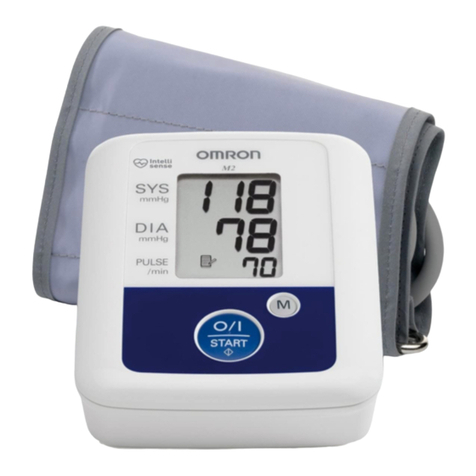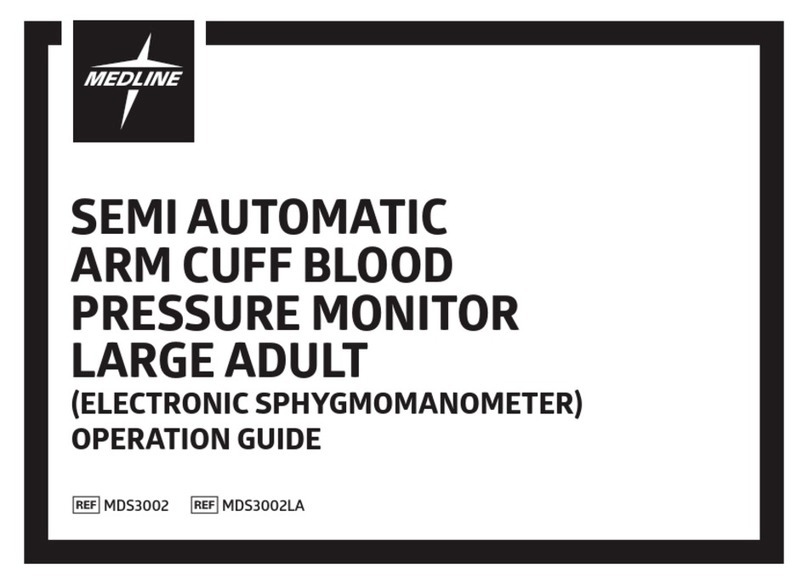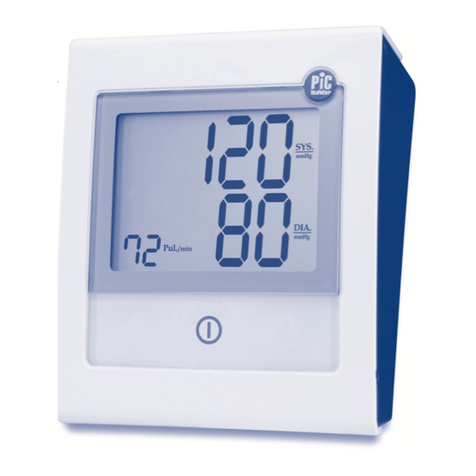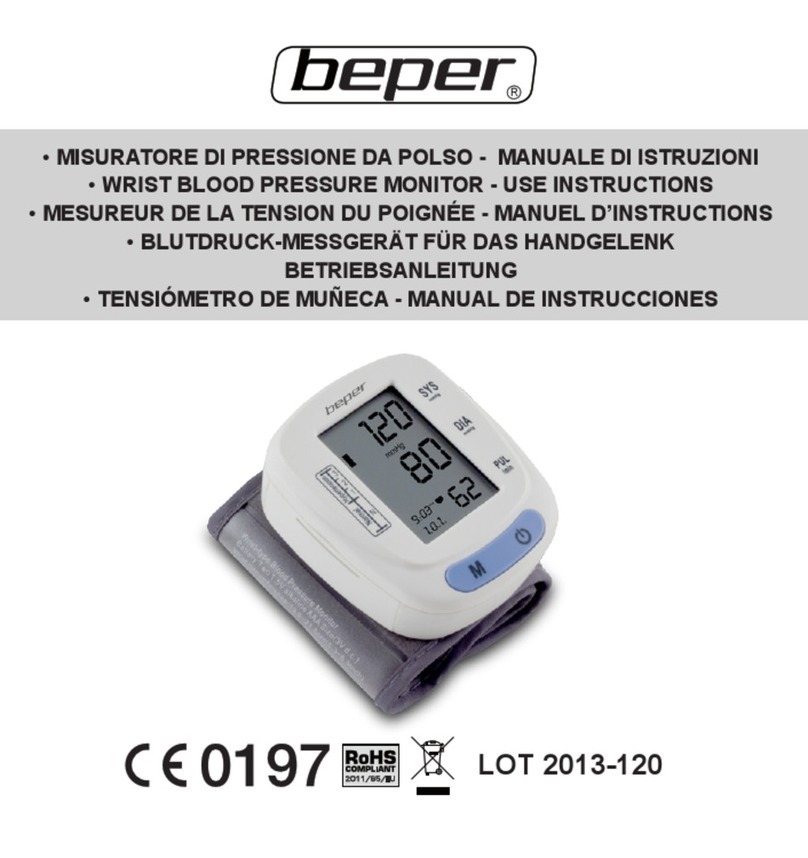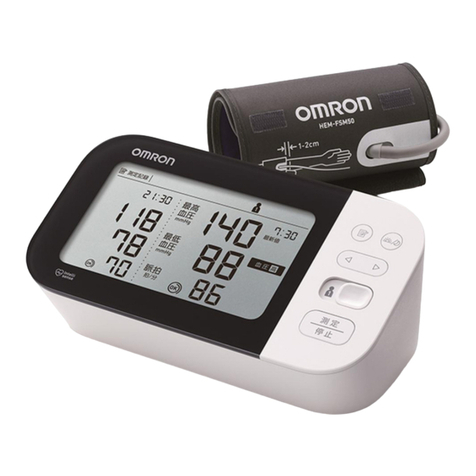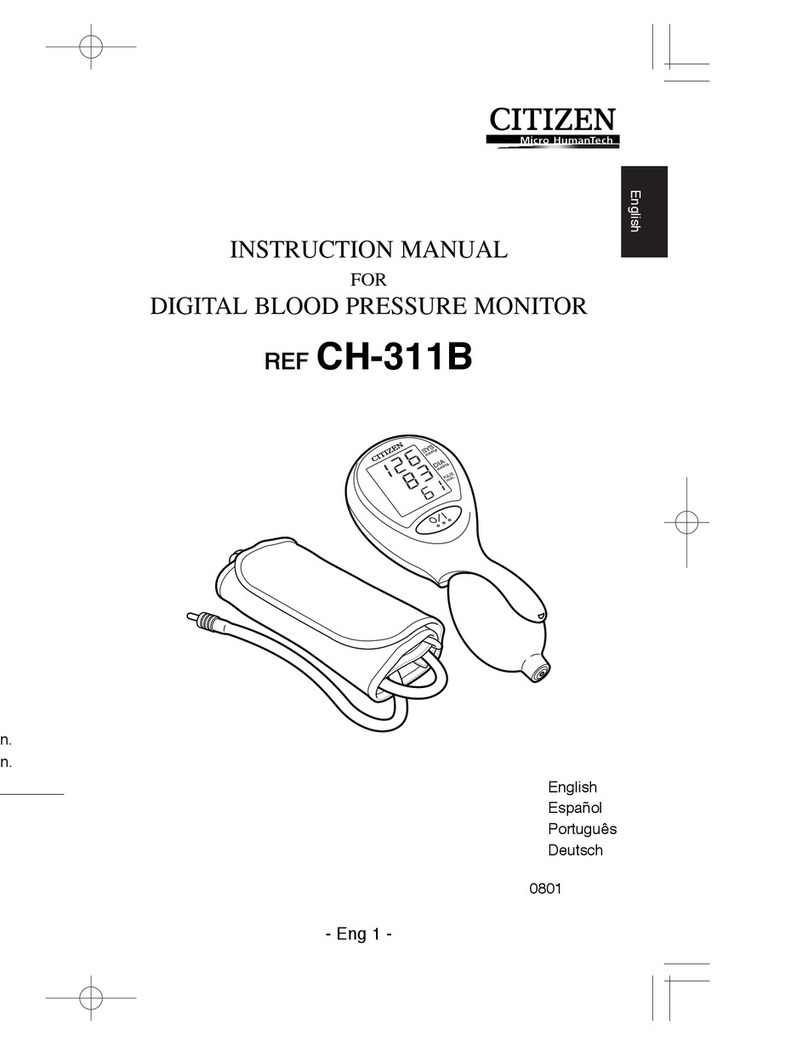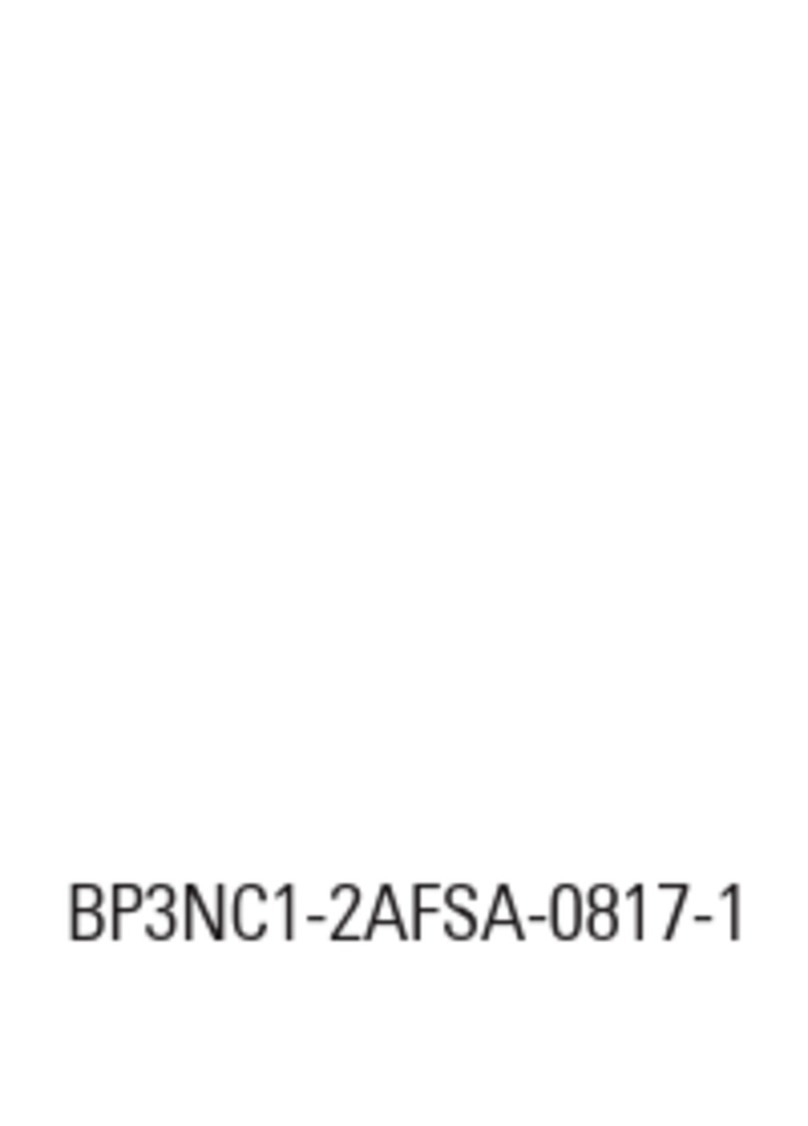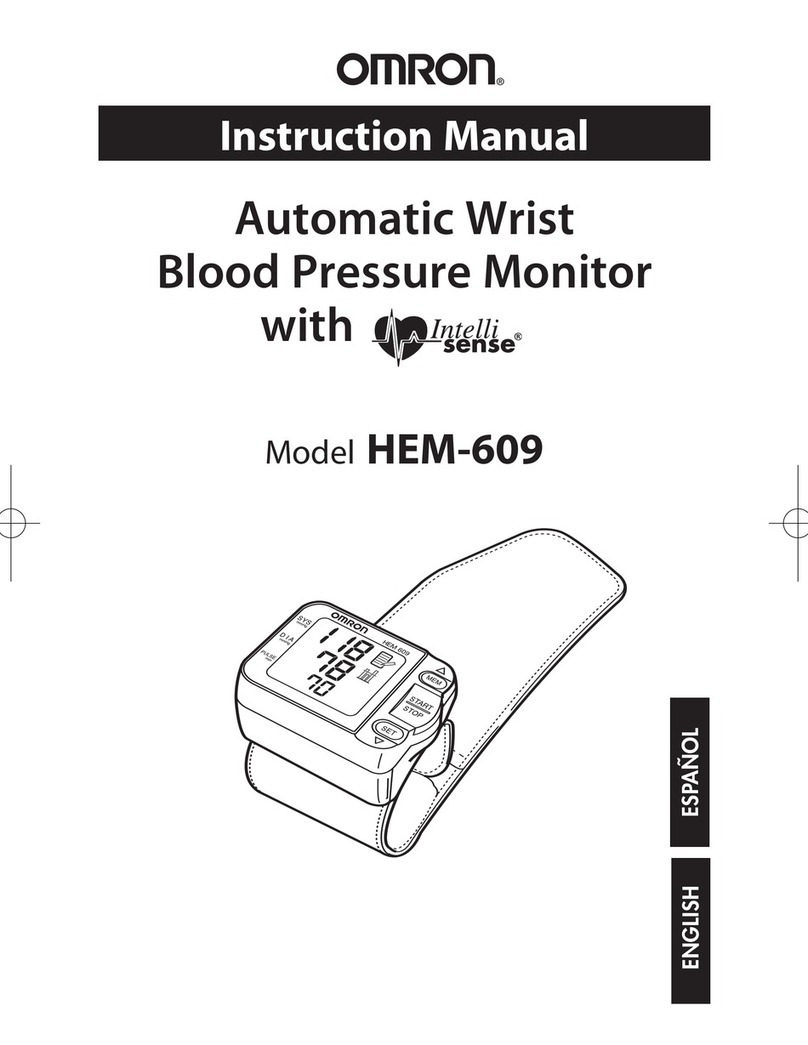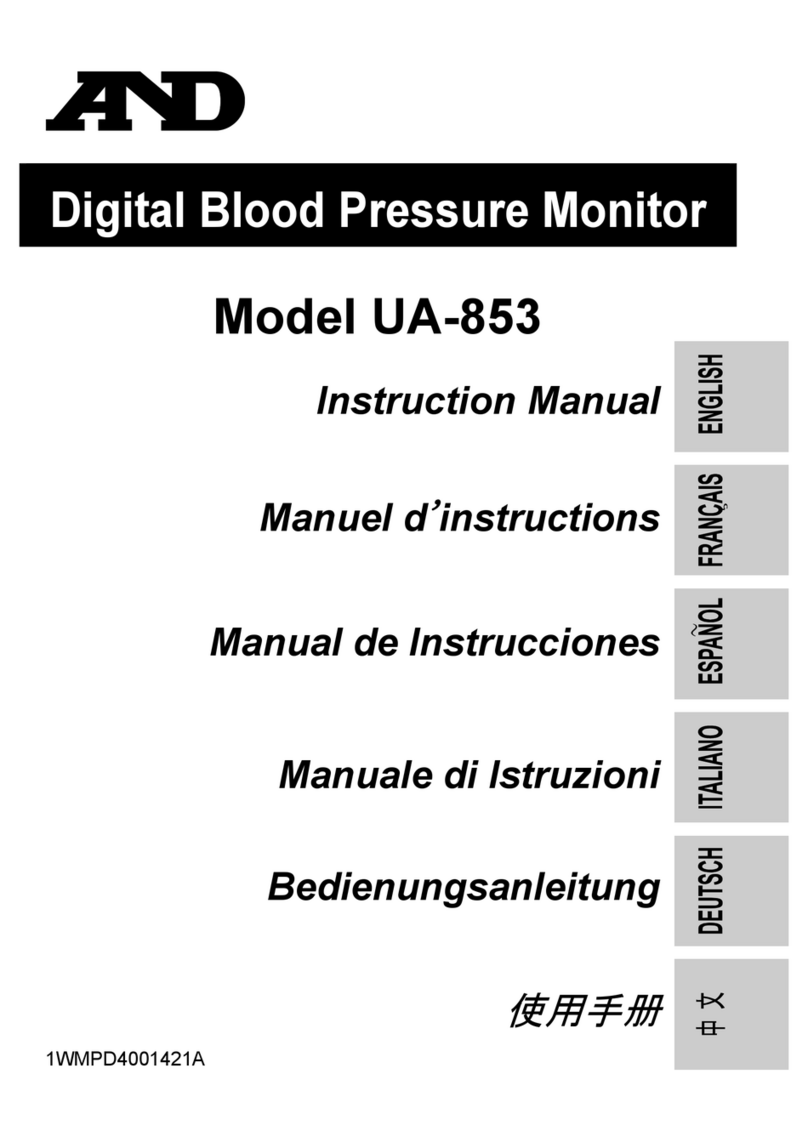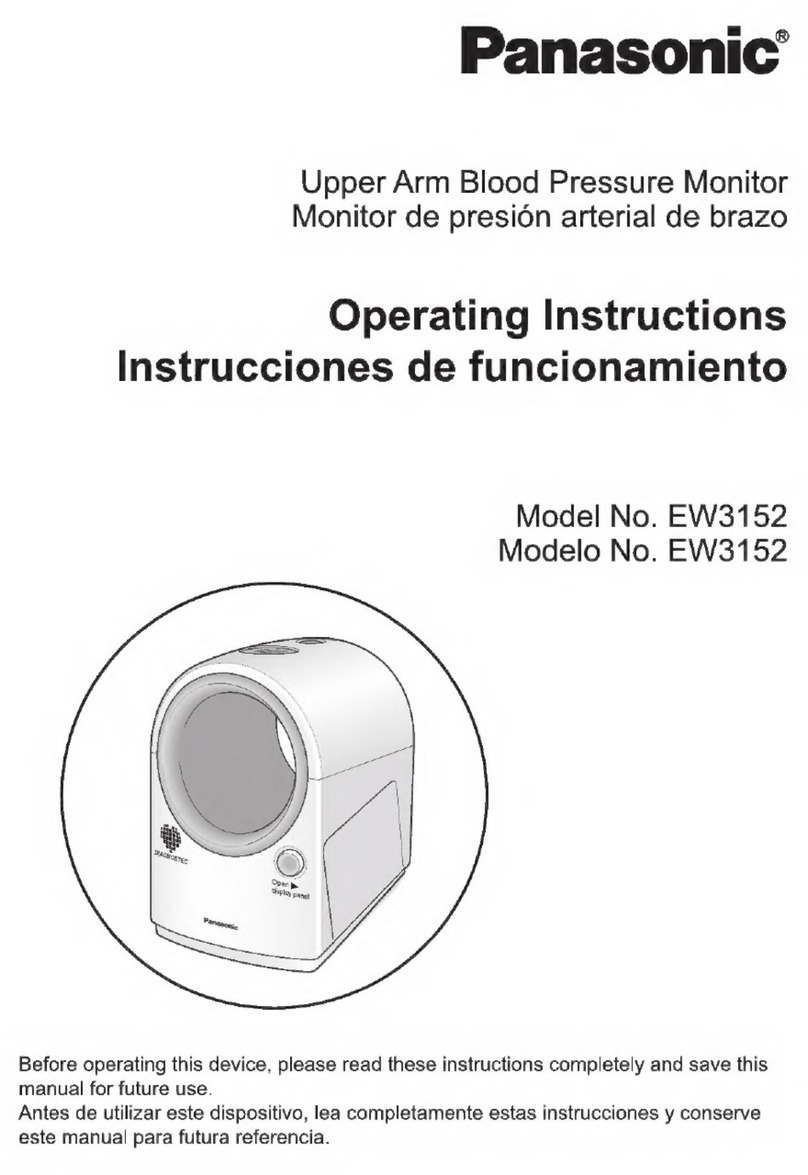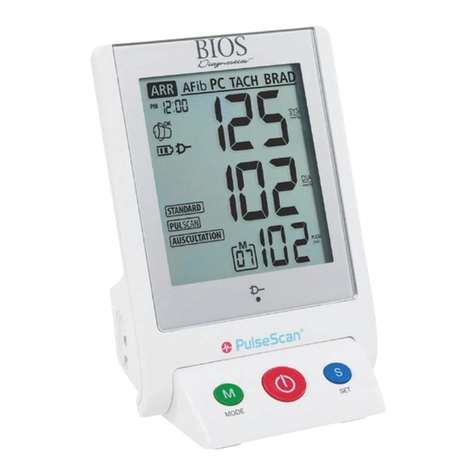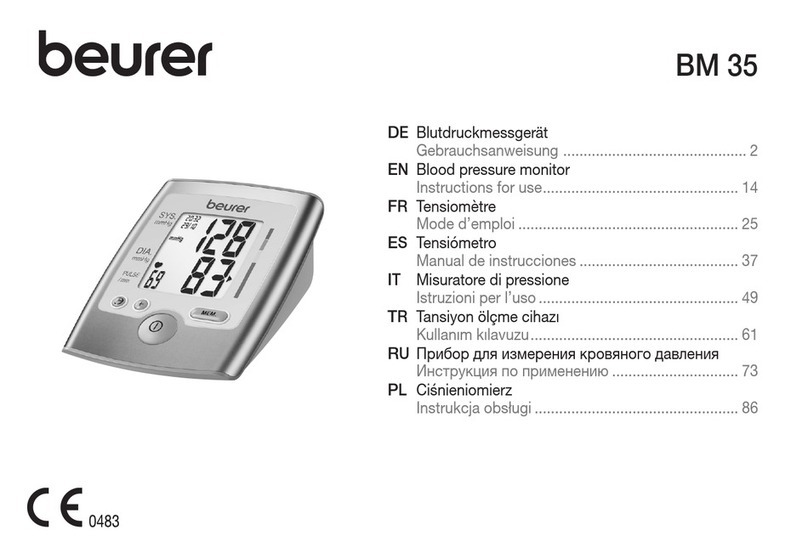Spacelabs Healthcare 90217A User manual

Ambulatory Blood Pressure Monitor
90217A
070-2177-01 Rev B | www.spacelabshealthcare.com
OPERATIONS MANUAL

Consult Documents
THIS SYMBOL MEANS YOU MUST READ THE ACCOMPANYING
DOCUMENTS
(Note: All further instances of this symbol will be represented in black & white)
WARNING - Actions or circumstances that may result in
personal injury or death.
(Note: All further instances of this symbol will be represented
in black & white)

iii
070-2177-01 Rev B
©2016 Spacelabs Healthcare Ltd.
All rights reserved. Contents of this publicaon may not be reproduced in any form without the
wrien permission of Spacelabs Healthcare. Products of Spacelabs Healthcare are covered by
U.S. and foreign patents and/or pending patents. Specificaons and price change privileges are
reserved.
Spacelabs Healthcare considers itself responsible for the eects on safety, reliability and
performance of the equipment only if:
• assembly operaons, re-adjustments, modificaons or repairs are carried out by
persons authorized by Spacelabs Healthcare, and
• the electrical installaon of the relevant room complies with the requirements of
the standard in force, and
• the equipment is used in accordance with the operaons manual.
Spacelabs Healthcare will make available, on request, such circuit diagrams, component part
lists, descripons, calibraon instrucons or other informaon which will assist appropriately
qualified technical personnel to repair those parts of the equipment which are classified by
Spacelabs Healthcare as fi eld repairable.
Spacelabs Healthcare is commied to providing comprehensive customer support beginning
with your inial inquiry through purchase, training, and service for the life of your Spacelabs
Healthcare equipment.
CORPORATE OFFICES
Spacelabs Healthcare Inc
35301 SE Center Street
Snoqualmie, WA 98065.
USA.
Tel: +1 425 396 3300
Fax: +1 425 396 3301
Spacelabs Healthcare Ltd
Unit B, Foxholes Centre,
John Tate Road,
Herord.
SG13 7DT. UK.
Tel: +44 1992 507700
Fax: +44 1992 501213
Brands and product names are trademarks of their respecve owners.
Caution:
Federal (USA) law restricts this device to sale by or on the order of a
medical praconer licensed by the law of the state in which he pracces
to use or order the use of the device.
CE marked in accordance with the Medical Device Direcve, 93/42/EEC
Security-related informaon is indicated in the following manner in this manual:.
“WARNING” - Actions or circumastances that may result in personal injury or
death.
“ATTENTION” - Acons or circumastances that could damage the equipment, produce
inaccurate data, or invalidate a procedure.
“NOTE” - Useful informaon for a product feature, funcon, or procedure.

ABP 90217A Operations Manual
iv
This page is intentionally blank

v
070-2177-01 Rev B
1. Operaon
1.1 Overview 1-1
1.1.1 ABP Monitor 1-1
1.2 ReplacingtheBaeries 1-2
1.2.1 MainBaeryReplacement 1-2
1.3 InializingtheMonitor 1-3
1.3.1 ConnecngDirectlytoaLocalReportGenerator 1-3
1.3.2 ConnecngDirectlytothePCInterface 1-4
1.3.3 ConnecngtotheBaseStaonviaModem 1-4
1.3.4 ModemSpeedandCompabilityIssues 1-5
1.3.5 OceCheckMode 1-6
1.4 PreparingthePaentandPrecauonsforUse 1-7
1.4.1 UsingCuSupport 1-11
1.4.2 OponalAccessories 1-11
1.4.3 CorrelangwithManualReadings 1-11
1.4.4 PaentInstrucons 1-12
1.5 DataTransferandReports 1-12
1.6 Cleaning/Disinfecng 1-12
1.6.1 CleaningtheCuandCarryingPouch 1-13
1.6.2 Removing/InstallingtheBladder 1-14
1.7 EventCodes 1-14
2 Accuracy
2.1 Checking Accuracy 2-1
2.1.1 Accuracy Procedure 2-2
3. Technical Data
3.1 90217A Ultralite ABP Monitor 3-1
3.2 ElectromagnecCompability 3-5
Table of Contents

ABP 90217A Operations Manual
vi
3.2.1 Generalnotes 3-5
3.2.2 Guidanceandmanufacturer’sdeclaraon–electromagnecemissions 3-6
3.2.3 Guidanceandmanufacturer’sdeclaraon–electromagnecimmunity 3-7
3.2.4 Guidanceandmanufacturer’sdeclaraon–electromagnecimmunity 3-8
3.2.5 RecommendedseparaondistancesbetweenportableandmobileRF
communicaonsequipmentandthe90217A 3-9
4. Troubleshoong
4.1 ProblemSolvingChecklist 4-1
4.2 Servicing 4-2
Appendix - Signs and Symbols

1-1
070-2177-01 Rev B
1. Operaon
1.1 Overview
The Spacelabs Healthcare Models 90217A Ambulatory Blood Pressure (ABP) monitors are
small, lightweight, battery-powered monitors designed to take blood pressure and heart
ratemeasurementsfor24or48hours,orforlongerperiodsoftime.
ThesemeasurementsarerecordedwithinthemonitorsandmaybetransferredtoLocal
ReportGenerator90239A,toReportManagementSoftware(90121or92506)(optionally
in Remote Connection mode using modems) or to CardioNavigator or Sentinel Cardiology
InformationManagementSystems.
The device shall be operated only by suitably competent personnel trained in the use and
proceduresofAmbulatoryBloodPressuremonitorsfordiagnosticpurposes.
EachABPmonitorwhenpurchasedcomeswithaStandardCuff,anABPpouch,1xbelt,1x
shoulder harness, 1 x Patient Instruction Diary.
1.1.1 ABP Monitor
The monitor has the following features:
• Four-digitliquidcrystaldisplay(LCD)
• Battery powered
• Serial communications port
• Power ON/OFF switch
• Reading START/STOP button
• Bloodpressurecuff
Themonitorsarecarriedinpouchesthatarestrappedand/orbeltedtothesideofthe
patient. Blood pressure and heart rate measurements are taken using a blood pressure

ABP 90217A Operations Manual
1-2
cuffattachedtothepatient’sarm.Thisinformationisrecordedinthemonitorsandcanbe
transferredoveramodemlinkorbydirectconnectionbetweenthemonitorsandoneof
the ABP analysis systems.
The monitors can be programmed to either activate or deactivate the following
features:
• Displaythecuffpressureateachbleedstep.
• Displaythesystole,diastole,andheartrateattheendofeachmeasurement.
• Bleedto40mmHgratherthanstoppingatthediastolicvalue.
• Beepbeforeandaftereachreading.
1.1.1.1 Front Panel
The90217AmonitorfrontpanelsincludetheLCDdisplay,cuffhoseconnector,andaSTART/
STOP switch.
1.1.1.2 Rear Panel
Therearpanelofthemonitorcontainsprograminputandoutputcommunicationports.
The ON/OFF switch is located on the top panel.
1.2 Replacing the Batteries
Three“AA”batteriesprovidethemainpowersourceforthemonitor.Thesebatteries
shouldbereplacedorrechargedbeforethestartofeachpatientmonitoringsession.Use
either alkaline or rechargeable batteries.
The90217Amonitorbackupbatteryshouldnotrequirereplacement.
1.2.1 Main Battery Replacement
1. Power the monitor OFF, and remove the door over the battery compartment.
2. Replacethe“AA”alkalineorrechargeablebatteries,beingcarefultoobserve
polarities.
• The monitor will not operate if the batteries are incorrectly installed. If
the monitor is going to be stored for an extended period of time, remove
the batteries to prevent the possibility of leakage or discharge.
• Spacelabs Healthcare is not responsible for product damage incurred
as a result of “AA” battery leakage. In the event your monitor has been
damaged by a leaking battery, contact the battery manufacturer for any
recoverable repair or replacement costs. Spacelabs Healthcare will assist
you in determining those costs.
3. Gently replace the battery cover and secure the latch.

1-3
070-2177-01 Rev B
PowerthemonitorON.CheckthattheLCDdisplayisON.Ifthereisnodisplay,powerthe
monitorOFFandreviewtheproblem-solvingchecklistinSection4.Troubleshooting.
Please ensure that discharged batteries, of all types, are disposed of in
accordance with local regulations.
1.3 Initializing the Monitor
TheABPmonitorsmustbeinitializedpriortothestartofpatientmonitoring.Initialization
specifiesthemonitoringperiod,patientinformation,timeformat,measurementinterval,
monitor tone ON/OFF during selected periods, event code display, and whether or not to
displaypressurevalues.Toinitializethemonitor,connectittooneofthefollowinganalysis
systems.
1.3.1 Connecting Directly to a Local Report Generator
For a direct connection, place the 90217A monitor into the chute on the Report Generator
(Model 90239A), See Fig. 1-1.
Figure 1-1: Report Generator

ABP 90217A Operations Manual
1-4
1.3.2 Connecting Directly to the PC Interface
ForadirectconnectiontoaPC-compatiblecomputerviaaModel90121,92506orSentinel:
1. ConnectoneendoftheABPinterfacecabletotheappropriateportonthe
computerwherethe90121,92506orSentinelsoftwareisinstalled.
2. ConnecttheotherendoftheinterfacecabletotheABPmonitor.
Refertoeitherthe90121ABPReportManagementSystemOperationsManual,the92506
ABP Report Management System Client Application Operations Manual, or the Sentinel
OperationsManualformoreinformationonthereportmanagementsystem.
ABP Monitor
PCwith92506orSentinel
softwareinstalled
USB or Serial
interfacecable
Fig 1-2: Configuration of direct connection to PC
1.3.3 Connecting to the Base Station via Modem
ForamodemconnectiontoaremotePCbasestation,refertoFigure1-3below.
To base station
modem Public telephone
network Modem
Phone
Cable to
serial port ABP
Monitor
Figure 1-3: Modem connection configuration
Note: The actual initialization procedure is discussed in the 90121 ABP Report
Management System Operations Manual (P/N 070-0529-xx) and in the 92506
ABP Report Management System Client Application Operations Manual (P/N
070-2160-xx).

1-5
070-2177-01 Rev B
1.3.4 Modem Speed and Compatibility Issues
The 90217A monitor operates Hayes-compatible modems only. The maximum
communication speed is 9600 baud. When the communications cable is plugged into the
monitor it should display 0999/9999
1.3.4.1 ConneconProcedure
Connect the serial port cable (P/N 012-0096-01) between the 90217A monitor and the
modem.
Note: If call waiting or call forwarding are options on a telephone used to transfer
data, ensure that both are deactivated. Otherwise modem communications
may be interrupted. In addition, telephone systems such as CBX or PBX can
cause interference with the modem, or the modem can cause interference
with the switching system..
To initialize the monitor for remote connection:
1. Contactthebasestationbytelephone(forremoteoperationonly).
2. Askthebasestationoperatortoinitializethemonitor.Givethefollowing
informationtotheoperator:
• Patient’sname
• Patient ID number
• Whether monitor display is to be active or not
• Timeofday(12-or24-hourformat)
• Whether to display measurement (systolic/diastolic and heart rate)
• Multipleorsinglecycletimes.Ifusingasinglecycleforthe24-hour
monitoring period, indicate the cycle interval and whether the tone is ON
orOFF.Formultiplecycletimes,specifyeachcycleintervalandwhetherthe
toneisONorOFFforeachcycle.
• Anyotherinformationthebasestationoperatormayrequest
Thebasestationoperatorwillenterthepatientinformationinthecomputer.
3. Preparethemonitortoreceivethepatientdatafromthebasestation.
• Power ON the modem.
• When instructed by the base station operator, power ON the ABP monitor.
Note: The modem link must be established within 45 seconds. If this does not
occur, power the monitor OFF and then ON again to retry establishing the
link.

ABP 90217A Operations Manual
1-6
Whenthetransferofinformationiscomplete,theABPmonitorwillbeep.Voice
communicationisrestoredafterthemonitorbeeps.
• PowerOFFthemonitoranddisconnectthemonitorfromthemodem.
• Ifadirectconnectionbetweenthemonitorandthebasestationisused,power
OFFthemonitorandthendisconnectitfromtheABPdatainterfaceunit.
1.3.4.2 Modem Indicator Lights
Modemindicatorsatthelocalmodemarelit,flashing,orunlitdependingonthestageof
operation. When the monitor is powered ON, the RD (Receive Data) and SD (Send Data)
lightswillflashforseveralseconds.TheOH(OnHook)indicatorbecomeslitwhenthe
monitor starts communicating with the remote modem. When the modems connect, the
CD(CarrierDetect)islit.TheSDandRDlightsflashasdataisbeingtransferred.
AfterthetransmissioniscompleteandthemonitorispoweredOFF,theHS,TR,andMR
indicators will always remain lit at the local modem
1.3.4.3 Setup Test
Note: Verify that the cable connections are secure.
Power ON the ABP monitor. It will display “9999.” While the monitor is being read or
initialized,thedigitswillchangetoindicatethatcommunicationistakingplacebetween
the monitor and the analysis system. When communication is complete, the digits will no
longer change.
1.3.5 Office Check Mode
ThemonitorautomaticallyentersanOfficeCheckmodeforthefirstfivemeasurements
immediatelyfollowinginitialization.Thisallowsyoutoverifytheperformanceofthe
monitoronanindividualpatientwithouttheneedforre-initializationtoresetthedisplay
features.
Note: The 90217A enforces a 30 second minimum pause between measurements
to allow reperfusion. If the START/STOP key is pressed too soon after the
previous measurement, the monitor will count down the required period
before automatically starting the measurement.
While in the Office Check mode, the monitor operates as follows:
• Displaysthecuffpressureoneachbleedstep.
• Displayssystole,diastole,andheartrateattheendofthemeasurement.
• Bleeds one step below the diastolic value as determined by the monitor.

1-7
070-2177-01 Rev B
1.3.5.1 TerminangOceCheckMode
PresstheSTART/STOPkeytwicetocancelasinglebloodpressurereading.TheOfficeCheck
mode is terminated when a blood pressure reading is cancelled.
Anyeventthatpreventsasuccessfulbloodpressuremeasurement(otherthanamanual
cancel)isnotcountedasoneofthefiveOfficeCheckmodereadings.
1.3.5.2 ReinstangOceCheckMode
TheOfficeCheckmodemaybereinstatedinthe90217A.
To reinstate the Office Check mode without initialization of the monitor:
1. Power ON the monitor.
2. Press and hold the START/STOP key when the version displays on the LCD.
3. Release the START/STOP key when EC03 displays on the LCD.
AnEC13willbeloggedtoindicatethetimeatwhichtheOfficeCheckwasreinstated.The
OfficeCheckmodewillbeenabledforfiveadditionalsuccessfulmeasurements.
1.4 Preparing the Patient and Precautions for Use
This unit is NOT for neonatal use, do not use on patients under the age of 3
years.
• The effectiveness of this unit has not been established in pregnant
(including pre-eclamptic) patients and therefore its use in these
circumstances is not recommended.
• Kinking of the tubing can result in interference of blood flow and
resulting harmful injury to the PATIENT caused by continuous CUFF
pressure.
• Excessively frequent measurements can cause injury to the PATIENT due to
blood flow interference.
• Do not apply the CUFF over a wound, as this can cause further injury.
• Do not apply the CUFF on any limb where intravascular access or therapy,
or an arterio-venous (A-V) shunt, is present as temporary interference to
blood flow could result in injury to the PATIENT.
• Do not apply the CUFF on the arm on the side of a mastectomy.
• Pressurization of the CUFF can temporarily cause loss of function of
simultaneously used monitoring ME EQUIPMENT on the same limb.
• Check (for example, by observation of the limb concerned) that operation
of the monitor does not result in prolonged impairment of the circulation
of the blood of the PATIENT.

ABP 90217A Operations Manual
1-8
• The performance of the device can be affected by extremes of
temperature, humidity and altitude that are outside the product’s
operating parameters.
• Factors such as common arrhythmias (e.g. atrial or ventricular premature
beats or atrial fibrillation), arterial sclerosis, poor perfusion, diabetes,
age, pregnancy, pre-eclampsia, renal diseases, patient motion, trembling,
shivering can all affect the performance of the device and its blood
pressure reading.
• The monitor should not be used in close proximity to any electrosurgical
equipment as the radiation from such equipment may affect the reading,
also the monitor and its accessories do not have protection against burns
to the patient from electrosurgical equipment
Note: • Blood pressure measurements determined with this device are equivalent
to those obtained by a trained observer using the cuff/stethoscope
auscultation method, within the limits prescribed by the ANSI/AAMI
standard SP10, ‘Manual, Electronic ofAutomated sphygmomanometers’.
• The fifth Korotkoff sound was used to determine overall efficiency.
• As in manual auscultatory methods, accurate readings may not always
be achieved under some conditions. Patient movement, the position of
the cuff relative to the level of the heart, extreme heart rates and blood
pressures, various arrhythmias, and the subject’s physiological condition
and other factors may hinder an accurate reading. Vibration, such as that
in a moving automobile, is an environmental problem that may affect
readings.
• Consult a physician for interpretation of pressure measurements.
After the monitor has been initialized, prepare the patient for monitoring as
follows:
• The monitor should be checked for damage before every procedure.
• The monitor should be cleaned between each patient. Refer to section 1.6
for further information.
1. PowerONthemonitor,itperformsself-testsatstart-up.WhentheLCDdisplays
thecurrenttime,themonitorisreadyforoperation.
2. Strapthemonitortothepatient’shipoppositethesideonwhichthecuff
isworn.Securethemonitorusingthepatient’sownbeltortheABPpouch
strapped over the opposite shoulder. When using the shoulder strap, use
thebeltsuppliedwiththemonitororthepatient’sbelttoprovideadditional
security.
3. Ensure the accuracy of blood pressure measurements through proper
cuff selection and application. To select the proper cuff, first measure the

1-9
070-2177-01 Rev B
circumference of the limb at the point where the cuff will be applied. Match the
limb measurement to the range of appropriate circumferences (in centimetres)
specified on each cuff.
Table2:CuffSizes,CircumferenceRangesandPartNumbers
Description Part Number Shelf Life Warranty
Childcuff,12-20cm,latexfreewithQuick/
Luer connect
015-0118-04Q 5years 90 days
Smalladultcuff,17-26cm,latexfree,with
Quick/Luerconnect
015-0067-04Q 5years 90 days
Adultcuff,24-32cm,latexfree,withQuick/
Luer connect
015-0068-05Q 5years 90 days
Largeadultcuff,32-42cm,latexfree,with
Quick/Luerconnect
016-0077-05Q 5years 90 days
Extralargeadultcuff,38to50cm,latexfree,
withQuick/Luerconnect
016-0109-04Q 5years 90 days
4. Positionthecuffsothatthecentreoftheinflatablebladderisdirectlyoverthe
brachialartery.Thecentreofthebladderlocationismarkedontheoutsideof
thecuff.Oncetheproperpositionisdetermined,thecuffmustbetightened
toensurethatitisequallysnugatthetopandbottomedgesandthatitisnot
kinked.Thisisespeciallyimportantonlargerarms.Insertafingerbetweenthe
cuffandthelimbtoensureitisnottootight.Itmaybenecessarytowrapthe
cuffwithitstailatanangletoachieveuniformtightness.Ifthecuffisnotequally
snugatthetopandbottomedges,thenumberofreadingsavailablewillbe
limitedandthemonitormayindicatethatthecuffisimproperlyapplied.
Toensurethebestresultsthepatientshouldbe:
1) Comfortablyseatedwith:-
a)thearmshouldberelaxedatthepatient’sside.
b) legs uncrossed,
c)bothfeetflatonthefloor,
d) back and arm supported.
2) ThemiddleoftheCUFFshouldbeattheleveloftherightatriumofthe
heart.
It is recommended that the PATIENT relax as much as possible and not talk
duringthemeasurementPROCEDURE,andthat5minshouldelapsebeforethe
firstreadingistaken.

ABP 90217A Operations Manual
1-10
• Avoid compression or restriction of pressure in the NIBP patient connector
tubes. Check that operation of the equipment does not result in prolonged
impairment of circulation.
• Do not apply cuff to areas of breached or injured skin.
• Use only Spacelabs Healthcare cuffs with this monitor. Using other
manufacturer’s cuffs may result in inaccurate readings, even if the
manufacturer’s recommended size is observed.
• If the cuff is too small, pressure readings may be falsely high; if a cuff is
too large it produces a falsely low reading. The bladder can be positioned
in the cuff for either the left or right arm.
• Do not use older ABP equipment fitted with Luer-lock hoses in any area
where other medical equipment using Luer fittings may be present. There
is a risk of misconnection of the ABP monitor to an IV line, with serious or
fatal consequences.
• Dispose of cuffs in a manner that conforms to local regulations.
5. Leadthehoseupthearmwiththecuff
Alternative
Position
Position 1
andplaceitacrossthebackofthe
patient. Drape the hose so it does not
causethepatientdiscomfortandis
not pinched shut by too tight a radius.
Thefollowinggraphicdisplaysthe
mostcommonpositionsforthecuff
hose.
Ensure that that hose and
strap are routed in such
a way that minmises the
possibility of becoming
wrapped around the
patient’s neck.
6. Connect the hose to the monitor.
7. Verifypropermonitoroperationbytakingoneormorebloodpressurereadings.
Push the START/STOP key to begin a measurement. Spacelabs Healthcare
recommendstakingthreereadingsintheofficesothatthepatientbecomes
comfortablewithoperationofthemonitorandthemeasurementprocess.
The operator should be close to the patient to ensure the conditions above are
met, where possible.
Ifanunexpectedreadingoccursthenafurtherreadingshouldbetaken.(The
unitwillenforcea30secondwaitafteranyreading)Ifanyeventcodemessage
appearsonthescreenconsultsection1.7fortheexplanation.

1-11
070-2177-01 Rev B
8. ShowthepatienthowtoenterinformationinthePatientDiary.Makesure
thepatientknowswhattodoifthecuffbecomesveryuncomfortableduring
ameasurement,ifitslipsoutofplace,orifeventcodesaredisplayedonthe
monitorscreen(refertoPatientInstructionsonpage1-9).Also,ensurethatthe
patientknowshowtocareforthemonitor.
9. Whenyouaresatisfiedthatthemonitorisoperatingproperly,theremaining
measurementsintheOfficeCheckmodemaybecancelled.RefertoOffice
Check Modeonpage1-8.
1.4.1 Using Cuff Support
Note: Keeping the blood pressure cuff in place is very important both for patient
comfort and for the accuracy of the readings. This becomes particularly
challenging when the arm has considerable taper, as is often the case with
obese patients.
1. Putthelargeloopofthesupportaroundtheoppositearm.Oncethecuffis
successfullyappliedtothepatient,adjustthelengthsothatthejunctionofthe
strapsfitswellbackontheshouldertowardstheneck.
2. Fastentherearshortstraptotherearofthearmpit.Becarefultocliptothe
material only and not to the bladder.
3. Fastenthefrontstraptothetoplayerofthecuffmaterialatthelocationwhere
thehoseexitsthecuff.Adjustthelengthofthesestrapstoapplyaminor
amountoftensiontoholdthecuffinthecorrectposition.
1.4.2 Optional Accessories
Table 3: Optional Accessories
Accessories Part Number
CuffSupportHarness 015-0070-00
Service Manual 070-2157-02
QuickDisconnectCoupling 712-0794-00
MaleQuickDisconnecttoLuerAdapter 712-0773-00
1.4.3 Correlating with Manual Readings
The monitor bleeds pressure in discrete steps (not continuously), using the oscillometric
methodofbloodpressuredetermination.Ifmanualpressurereadingsaretaken
simultaneouslywiththemonitorreadings,interpolationisrequiredtoaccuratelycorrelate
monitor systolic and diastolic pressure values with the manual auscultatory pressures.
• Forsystole,recordthefirstpressureatwhichaKorotkoffsoundisheard.Actual
systolic pressure is somewhere between the pressure when the sound is heard

ABP 90217A Operations Manual
1-12
andtheprevious(higher)pressurewherenosoundwasheard.Theintervalof
uncertaintycanbereducedbyhalfbyaddingonehalfofthebleedstepsize
(4mmHg)tothemanualsystolicpressure.
• Fordiastole,recordthecuffpressureatwhichthelastKorotkoffsoundwas
heard. Actual diastolic pressure is somewhere between that pressure and the
nextlowerpressure.Theintervalofuncertaintycanbereducedbyhalfby
subtractingonehalfofthebleedstepsize(4mmHg)fromthemanualdiastolic
pressure.
1.4.4 Patient Instructions
Ifthecuffbecomesuncomfortableduringareading,makecertainthatthepatientknows
howtoterminatethereadingsbypressingtheSTOPkeyonthefrontofthemonitor,andin
theeventthatdiscomfortpersiststheyshouldfullyremovethecuffandinformthedoctor.
Ifthecuffslipsoutofplace,makecertainthatthepatientknowshowtocorrectly
repositionthecuffforsuccessfulreadings.Ifthecuffisnotproperlypositioned,event
codes may appear on the monitor.
• The patient should make every effort to keep the monitor dry. However,
there is no hazard if the monitor does get wet. If this occurs, power the
monitor OFF and return it to Spacelabs Healthcare for service.
• The monitor should be kept within the pouch at all times.
1.5 Data Transfer and Reports
Aftermonitoringiscomplete,connectthemonitortoeitheraPCDirectorBaseStation
interfacetotransmitpatientdataandgeneratebloodpressurereports.Refertothe90121
ABPReportManagementSystem,the92506ABPReportManagementSystemClient
Application, Cardionavigator CIMS User Manual or Sentinel CIMS User Manual, or the
90239ABPReportGeneratorOperationsManualsformoredetails.
Note: Pulse rates obtained from the ABP monitor should be used only as an
indication for the heart rate.
1.6 Cleaning/Disinfecting
Visuallyinspectthemonitor,airhose,andpressurecufffordirt,debris,frayedorworn
areas, etc. prior to patient use.

1-13
070-2177-01 Rev B
• Use only recommended cleaning solutions, or you may void the
manufacturers warranty.
• Harsh chemical agents degrade plastics and will compromise the safety of
the device.
• Before cleaning the monitor or cuff, disconnect from the patient.
• Do not allow liquid to enter the interior of the equipment.
• Do not immerse the equipment or cables in water or cleaning solutions.
• Do not autoclave - this unit CANNOT be sterilized.
To clean the exterior of monitors, modules, and cables:
• Preparethecleaningsolutionaccordingtothemanufacturer’sinstructions.
• Wet a clean cloth with the selected cleaning solution.
• Removeexcessliquidfromtheclothandsqueezedry.
• Wipeexposedsurfacesoftheequipmentandcables.
• Remove any soap residue by gently wiping with a clean damp cloth.
• Wipe dry with a clean dry cloth.
Use only the following recommended cleaning solutions:
• Mild soap and water solution.
• U.S. Pharmacopoeia (USP) green soap.
• Sodiumhypochloritesolution(1:10dilutionofhouseholdchlorinebleachin
water).
• Phenolicgermicidaldetergent(1%aqueoussolution).
• Glutaraldehyde(2.4%)(Cidexorequivalent).
• Isopropyl alcohol (70% solution).
Note: Over time, repeated use of a chlorine bleach solution may cause some
colors to fade.
Tape adhesive can be removed with Spacelabs Healthcare adhesive tape remover pads (P/N
392196-001).
QuestionsandconcernsaboutcleaningissuesshouldbedirectedtoaSpacelabsHealthcare
fieldserviceengineer.
1.6.1 Cleaning the Cuff and Carrying Pouch
Small soiled or stained areas may be cleaned by gentle scrubbing with a sponge or cloth
soaked in a mild soap and water solution.
Thecuffwrap(withtheairbladderremoved)andthepoucharemachinewashableon

ABP 90217A Operations Manual
1-14
“delicate” cycle only. Do not wash them in large commercial-type washers or with bed
linens or gowns.
Ensurethatthecarryingpouchisdrybeforere-use.
1.6.2 Removing/Installing the Bladder
Toremovethebladder,followthestepslistedbelow:
1. Usingfingersonly,foldorrollupthebladderinsidethecuff.Donotusepencils,
pens,orotherhardobjects,becausethesemaydamagethebladder.
2. Remove the bladder through the hose exit opening.
Oncethebladderisremoved,matetogetherthehook-and-loopsurfacesofthevelcro
attachmentbeforewashing.
Re-installthebladderintothecuffwrapinreverseorder.Makecertainthatallfoldsinthe
bladderareremovedandthatthelongendofthebladderfitsintothelongendofthecuff
(refertoBladderconfiguration).
Note: The cu hose can exit from either opening in the cu, depending on whether
you plan a right arm or le arm applicaon.
1.7 Event Codes
Themonitorsdisplayaneventcodewheneveraneventpreventsthemonitorfrom
successfullycompletingabloodpressuremeasurement.Thetwonumericaldigitsofthe
event code indicate the reason the measurement was aborted. The table below lists event
codes that are displayed on the monitor, as well as event codes that appear on the Event
Code Report.
Monitor Report Condition
EC00
EC10 Excessmovementartifact.FrequentEC10messagesmayindicateanair
leak.
EC20 A)Averylargenumberofmovementartifacts
B) Heart rate arrhythmia
EC30 A)Movementartifactatmeanarterialpressure
B) Heart rate arrhythmia
EC40 A)Movementartifactatsystole
B) Heart rate arrhythmia
EC50 A)Movementartifactatdiastole
B) Heart rate arrhythmia
Table of contents
Other Spacelabs Healthcare Blood Pressure Monitor manuals

